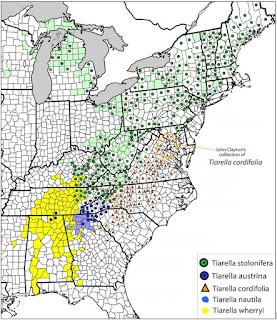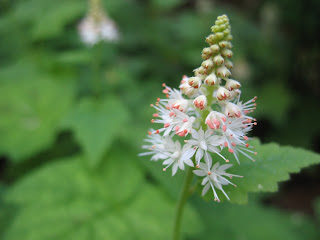You never forget your first favorites. Foamflower was one of
the first native plants that I learned as well as being an early favorite for
its beautiful flowers and foliage. It is also very easy to grow and fairly
available for purchase. Tiarella cordifolia
was the scientific name that I learned. There is new information out there now
to suggest that the plant I have in my area has a new name.
According to a new article by Guy Nesom: “Based on study of herbarium collections and foot-to-ground
observations in 2021 in Alabama, Georgia, North Carolina, South Carolina, and
Tennessee, I found that not one but five species of Tiarella are present in the eastern United States!” The map
that he provides shows that the area where I live is exactly in a new species
territory (Tiarella nautila):
 |
| Figure 1 from Guy Nesom's article |
The article clearly presents the information on which the new species are based and I encourage you to read it. The following quote quickly gives you the basis for the separations:
“The main features distinguishing them are presence/absence of stolons, shape of the basal leaves, and presence/absence of leaves on the flowering stem. When the plants are sorted by these physical characters, the five entities are remarkably consistent in geography, showing sharp boundaries with very little overlap (Figures 1, 2).”
I went back through all of the pictures I've taken of foamflower - in the wild, in my garden, in other gardens - and looked for leaves on the flowering stems. Regarding the presence of stolons: only once in the last twenty years have I come across a plant with noticeable stolons. That was on a field trip to northeast Georgia (perhaps Rabun County). Based on photos in the linked paper (see the references in Nesom's article), this may be Tiarella stolonifera.
 |
| From NE Georgia, possibly Tiarella stolonifera |
 |
| This photo from Sosebee Cove (NE GA) shows leaves on flowering stems so it is likely Tiarella nautila |
 |
| This photo from The Pocket in NW Georgia shows no leaves on flowering stems and leaves longer than wide, possibly Tiarella wherryi |
Whichever one you have, foamflower is a wonderful native
perennial and quite worthy of use in the shade and part-shade garden as well in
restoration sites that have its habitat. Both the flowers and foliage are
extremely attractive. Basal leaves often persist through the winter, offering a
bit of winter interest.
 |
| NE GA, bracts on stems |
 |
| NW GA (Cloudland), tiny leaf |

No comments:
Post a Comment